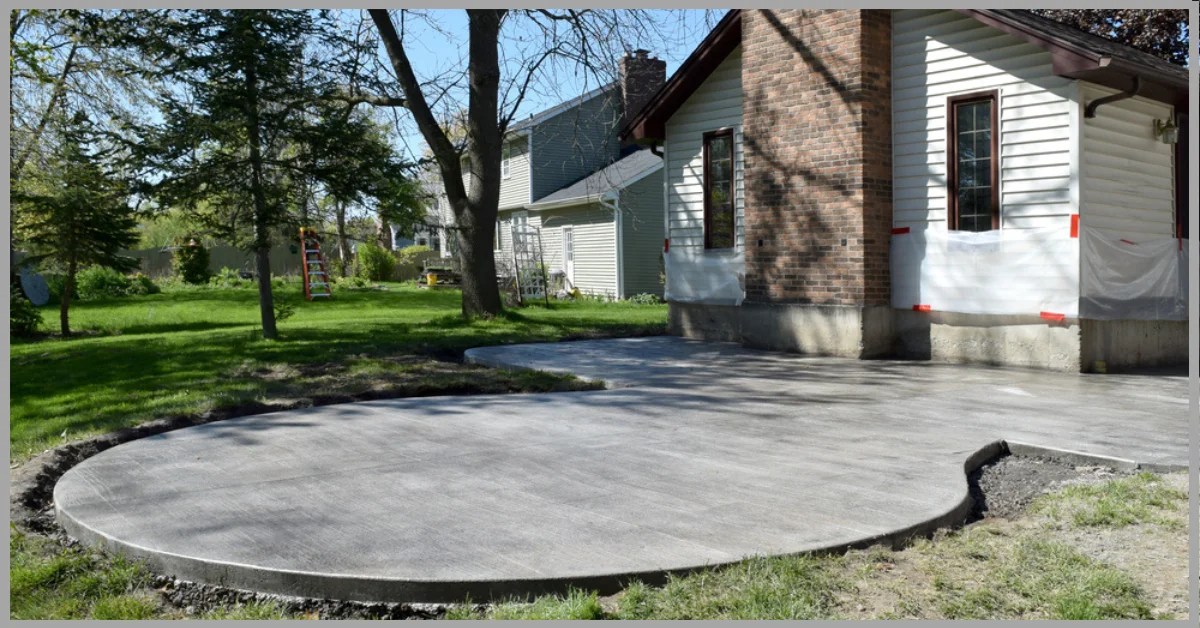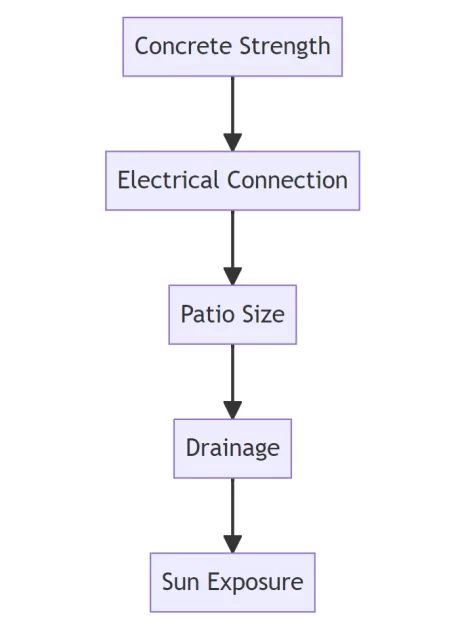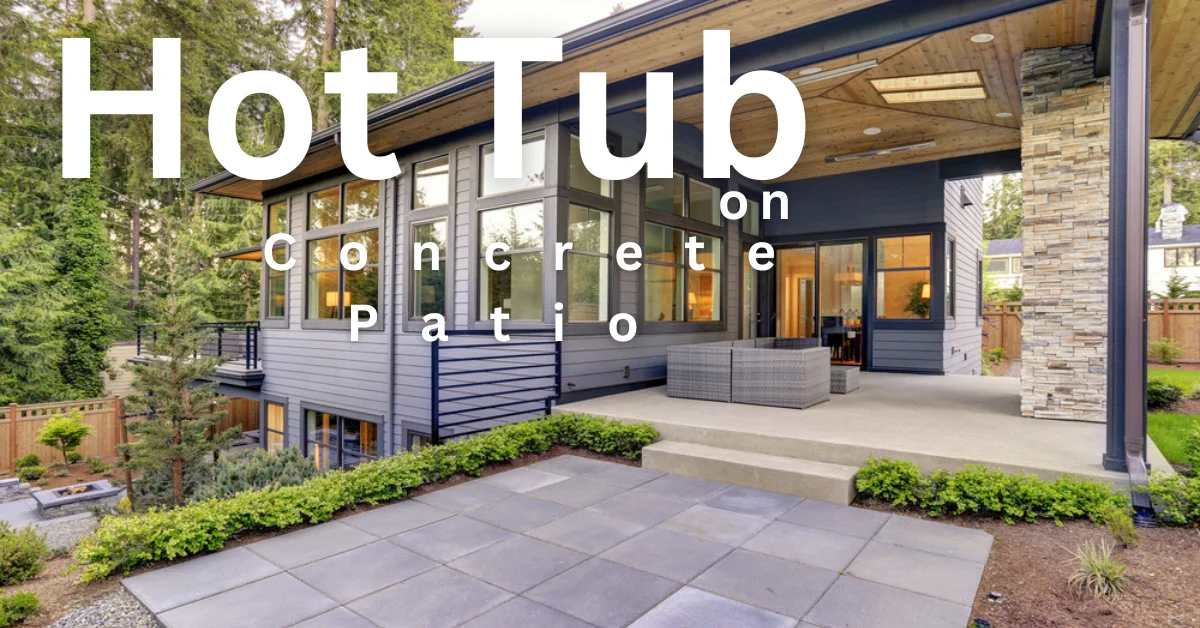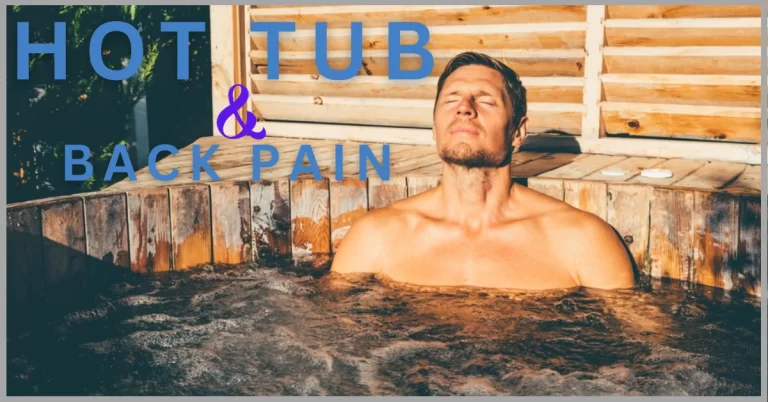Don’t Let Your Hot Tub Plans Crumble: Prepping Your Concrete Patio
Getting a hot tub is incredibly exciting! To ensure a safe and enjoyable experience, a strong foundation is essential. Here at Hot Tub Patio, we’re dedicated to helping hot tub owners and enthusiasts. We provide expert advice and resources to make sure your hot tub setup is a success.
Yes, you can definitely put a hot tub on a concrete patio! Concrete provides a strong, stable, and weather-resistant foundation. Just make sure your patio is:
- Thick Enough: At least 4 inches of reinforced concrete is recommended.
- In Good Condition: It should be free of cracks and level.
- Consider a Hot Tub Pad: While optional, a pad adds insulation and cushioning.

Why Concrete Patios Are Great for Hot Tubs
- Stability: The Solid Foundation A hot tub filled with water is incredibly heavy! Concrete provides an unyielding, level base that prevents your hot tub from shifting or settling unevenly. This stability is crucial for safety and preventing stress on the hot tub’s structure.
- Durability: Built to Last Concrete withstands harsh weather conditions, from freezing temperatures to blazing sun. Unlike some other materials, it won’t warp, rot, or become unstable under the constant weight of your hot tub. This means your patio will remain a reliable hot tub support for years to come.
- Easy Maintenance: Less Fuss, More Relaxation A concrete patio’s smooth surface makes cleaning a breeze. Spills and splashes are easily wiped away, keeping your hot tub area neat and inviting. With minimal maintenance required, you’ll have more time to actually enjoy your hot tub!
Is Your Existing Patio Suitable?
Not all concrete patios are created equal when it comes to hot tub support. Here’s what to check before setting up your spa:
- Thickness Matters: For most hot tubs, a minimum thickness of 4 inches of reinforced concrete is recommended. A thinner patio might crack under the weight of a filled hot tub. If you’re unsure of your patio’s thickness, it’s best to consult a professional.
- Condition is Key: Even a thick enough patio won’t do the job if it’s damaged. Cracks, chips, or uneven areas need to be repaired before you install your hot tub. These imperfections can worsen under the load and create safety hazards.
- The Level Factor: Picture trying to fill a bathtub on a slope – not ideal! Even a slight slant in your patio can cause your hot tub to sit unevenly, putting stress on its structure and potentially affecting water circulation.
What if my patio doesn’t fit these criteria? Don’t worry! We’ll cover alternative hot tub foundation options in a later section of this blog.
Prepping Your Concrete Patio for a Hot Tub
Even a suitable concrete patio usually needs a bit of prep before becoming your hot tub haven. Follow these steps:
- Step 1: Clean and Inspect: Start with a thorough cleaning. Sweep away leaves and debris, and pressure wash if needed. This lets you closely inspect for any damage. Small cracks or chips can be repaired with DIY concrete patching compounds. For severe damage or if you notice a slope, it’s best to call in a concrete professional for assessment and possible leveling services.
- Step 2: Consider a Hot Tub Pad (Optional): While not strictly necessary, a hot tub pad placed on your patio adds a layer of insulation and comfort. These pads help retain heat, potentially lowering your energy bills. They also cushion the hot tub’s base, which can prolong its lifespan.
Tips:
- Think about access: Will you need space around the hot tub to access equipment? Factor this in when planning its placement.
- Electrical considerations: If your hot tub requires electrical work, consult an electrician to ensure safe and code-compliant installation.

Benefits
- Strong Support: Concrete won’t sag or shift under the weight of a filled hot tub.
- Durability: Concrete resists weather damage and will last for years.
- Low Maintenance: A smooth concrete surface is easy to keep clean.
Things to Check Before Install
- Thickness: Your patio needs to be at least 4 inches thick and reinforced.
- Condition: No cracks or unevenness – those need fixing first.
- Drainage: Make sure your patio slopes slightly away from where the hot tub will sit to prevent water pooling.
- Electrical Setup: Most hot tubs need a dedicated electrical circuit – check if you have the right one available.
Bonus Tip: Consider a hot tub pad on top of your concrete patio for extra insulation and comfort!
[wps_youtube url=”https://youtu.be/-FzwSA_lf7w” width=”600″ height=”400″ responsive=”yes” autoplay=”yes”]
Beyond Concrete: Other Hot Tub Base Options
If your existing concrete patio isn’t ideal or you simply don’t have one, don’t worry! Here are some excellent alternatives:
| Aspect | Concrete Base | Wooden Deck Base | Gravel Pad Base |
|---|---|---|---|
| Load-Bearing Capacity | Excellent | Requires reinforcement | Good if compacted |
| Installation Complexity | Moderate | More complex | Relatively simple |
| Aesthetics | Functional | Versatile, can be visually appealing | Less appealing |
| Maintenance | Low | Regular upkeep needed | Minimal |
| Durability | Long-lasting | Moderate, needs protection from weather | Less durable |
| Comfort | Solid footing | Softer surface | May be uneven |
| Cost | Moderate | Generally more expensive | Affordable |
| Environmental Considerations | Production impacts | Wood sourcing, decay | Natural, may need replacing |
- Reinforced Decks: A good option with proper structural support (consult a contractor).
- Pavers: Stable, customizable look.
- Specialized Hot Tub Pads: Quick, easy, provide insulation.
[wps_alert type=”success”]Important Reminder: Always ensure your chosen base is level, strong enough to support the hot tub’s weight, and meets any local building code requirements.[/wps_alert]
DIY vs. Professional Hot Tub Installation
Choosing between DIY and professional installation for your hot tub is important. DIY can save money, but requires skill and time. Professional installation ensures safety, quality, and often includes warranties.
| Aspect | DIY Installation | Professional Installation |
|---|---|---|
| Cost | Lower upfront cost | Higher cost due to labor |
| Expertise | Requires knowledge | Done by experts |
| Time | More time-consuming | Faster completion |
| Safety | Potential for errors | Ensures safety standards |
| Warranty | Limited/none | Often includes warranties |
[wps_note size=”17″ background=”#fae588″ color=”#333333″ radius=”3″]Remember, the decision between DIY and professional installation depends on your comfort level with the process, available time, budget, and the importance of a safe and reliable installation.[/wps_note]
For additional information, visit Hot Tub Patio, or if you’re interested in more reading, see Guides and Reviews.
Final Words:
A well-prepared concrete patio offers strength, durability, and easy upkeep for your hot tub haven. Remember, the right foundation is key to maximizing the lifespan and enjoyment of your investment.
Discover the ultimate relaxation oasis by exploring the perfect combination of a Patio with Hot Tub and Fire Pit on Hot Tub Patio.
Have more questions about hot tubs, bases, or accessories? We’re here to help! Visit Hot Tub Patio for expert guides, resources, and a community for fellow hot tub enthusiasts.
We love seeing how you create your ideal hot tub space! Share photos or descriptions of your hot tub setup in the comments below. Let’s inspire each other!














One Comment